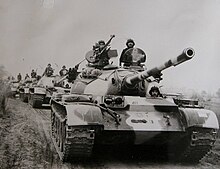

| Pakistan Armoured Corps | |
|---|---|

Badge of the Armored Corps
| |
| Active | 1947; 77 years ago (1947) |
| Country | |
| Branch | |
| Role | Combat and combined arms administrative and staffing oversight. |
| Size | 52 regiments[1] |
| HQ/Garrison | Nowshera Cantonment, Khyber-Pakhtunkhwa in Pakistan.[2][3] |
| Nickname(s) | AC Men of Steel[4] |
| Color identification | Red and Yellow |
| Anniversaries | 1947 |
| Engagements | Military history of Pakistan |
| Commanders | |
| Director-General | Maj-Gen. Zafar Iqbal Marwat |
| Notable commanders | Lt. Gen. Shah Rafi Alam
General Jehangir Karamat Lt Gen.Shaheen Mazhar Mehmood |
| Insignia | |
| War flag |  |
| Administrative Corps of the Pakistan Army | ||||
|
The Pakistan Army Armoured Corps is a military administrative and combined arms service branch of the Pakistan Army.[3]
Headquartered in Nowshera, Khyber-Pakhtunkhwa in Pakistan, the corps is commanded by its director-general, Major-General Zafar Marwat as of 2023.[2]
The Pakistan Army's armored corps was commissioned as an administrative corps from the partition of the former British Indian Army's Armoured Corps– there were six regiments that formed the basis of the Armoured Corps.: 156 [5][6]
During the early years, the British Army officers played a crucial role in running the military operations from the Nowshera Cantonment which remains till this day Armoured Corps' headquarter.: 83 [7] Until 1956, the training and field manuals were based on British Army but later adopted U.S. Army's field manual and training, which is continue to be practiced by armoured corps' training school.[8] The School of Armor and Mechanized Warfare trains cadets and officers to be a part of the Armored Corps at the Nowshera Cantonment.[9] The Armored Corps is commanded by the director-general who is usually at two-star active duty rank, Major-General, working directly under the Chief of the General Staff at the Army GHQ in Rawalpindi.[8]
The Armoured Corps only has an administrative control over its combat strike brigades and such brigade teams are employed in numbers of strike maneuver corps to defend the national borders of Pakistan from the foreign threats.[10][11][12][13]
Until 2001, the armoured corps was focused towards opposing Indian advances in the east but later stationed its interests in western border to prevent foreign threats coming from Afghanistanr.[14]
|
|
  
|
Armoured Corps regiments are equipped with the following:
|
| ||
|---|---|---|
| ||
| International |
|
|---|---|
| National |
|